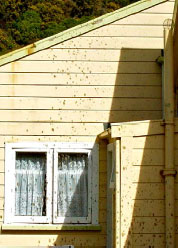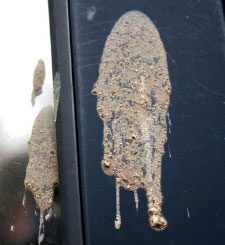 We have investigated numerous claims since September 2003 where residents, of mostly rural areas, have complained of a foul smelling substance being splattered over their properties.
We have investigated numerous claims since September 2003 where residents, of mostly rural areas, have complained of a foul smelling substance being splattered over their properties.
The residents have queried whether this substance has come from an aircraft toilet.
Pictures submitted by the complainants all showed reasonably large areas (some about 4-6 m2), splattered with a brown substance. Some of the pictures indicated a clear direction to the splatter pattern, including splatter under the eaves of one house.
Nearly all the cases reported to us have been between August and November in any given year.
Modern airliner toilets cannot be emptied in flight. While this may have been the case in the early days of aviation, sealed toilet systems were installed as far back as the 1950s.
The toilets can be emptied only while the aircraft is parked on the ground. That's achieved by connecting to a septic tanker unit, and only after numerous hatches and valves are manipulated manually. This task is carried out by trained airline ground staff several times a day, and the system is drained, flushed, recharged and checked at the same time.
Each toilet holds a 20-litre charge of a water and Novirusac solution. Novirusac is a blue deodorant chemical.
The hull of an airliner is basically a sealed tube which is pressurised to maintain an altitude of about 8000 feet inside. This is so aircraft can operate efficiently at much higher altitudes for a given route. The aircraft’s toilets are within that sealed hull and are designed to operate at all altitudes. The toilets cannot overflow, as their collection tanks are large enough to hold the total contents of all the toilets in the aircraft. Aircraft toilets do sometimes get blocked, most commonly by incorrect passenger use, or by component failures. The cabin crew will be notified of any problems, and their procedures are to simply isolate that particular toilet from use.
Internal leakage may occur, but any matter that does leak will still be trapped within the pressurised hull. Aircraft hulls are not 100 percent airtight so there is a possibility that some liquid matter (blue in colour and deodorised) may seep outside. This will leave a ‘telltale’ blue streak mark along the outer fuselage which will alert ground staff to a possible leak in the toilet system. There are no gaps in the fuselage big enough to allow solid waste to escape. If such a hole was to develop, the aircraft would experience a rapid depressurisation requiring an emergency descent.
One must also consider the altitude and speed of an airliner (200 kph – 800 kph) and the effects these factors will have on any liquid that may seep out. At that speed any liquid would dissipate and evaporate in the atmosphere very quickly.
 The airline industry is highly regulated and airlines must all demonstrate to us that they have a robust internal reporting system for all incidents and defects. These occurrences are reported to us and an independent investigation into a given occurrence may be launched.
The airline industry is highly regulated and airlines must all demonstrate to us that they have a robust internal reporting system for all incidents and defects. These occurrences are reported to us and an independent investigation into a given occurrence may be launched.
We have had no reports of toilets leaking in flight. There have been a few occurrences reported where toilets have failed in flight and crew have isolated them from use, and a few cases where engineering inspections have found evidence of toilet leakage, but none of these have resulted in loss of toilet contents overboard.
In a 2003 case, one of our investigators collected a sample from a house and had it tested by a local laboratory. The test was for the presence of the chemical deodoriser Novirusac, but the result was inconclusive.
In 2010, the Institute of Environmental and Scientific Research (ESR) was engaged by the Auckland Regional Council to test another sample taken from a South Auckland property. The test result was also inconclusive, but did indicate a strong presence of sterol which is related to human waste. It was a curious result, but a probable explanation - given that expert opinion is that waterfowl are the source of the sprays of excrement - could be that the birds are known to feed in various waterways and ponds, including wastewater treatment ponds. It's of further note that the sample was sent to ESR almost three weeks after the 'event', and was not a good quality sample: some tests were unable to be conducted.
The ideal time for testing is within a few days, before the sample dries out and degrades.
While the two tests were inconclusive, they did indicate there was no definitive link between them as would be expected if they were from the same source.
A sample from a house in Tawa, near Wellington, was taken to the Department of Conservation Science and Research Unit to be viewed by Dr Murray Williams, their waterfowl biologist at the time.
The dry sample was viewed under a 3D-dissecting microscope, and Dr Williams found it was typical of what he would expect dried-out waterfowl excrement to look like. It was predominantly fibrous in content and appearance. Some plant remains were clearly undigested and still green in colour, and the cell contents were fully intact.
The sample was then hydrated and a small portion viewed with a powerful microscope at 25x and 40x magnification. Dr Williams noted that, in his opinion, the structure was typical of digested plant material.
 In his report, Dr Williams also explained the nesting habits of most waterfowl species. During the nesting incubation period, roughly between August to October, the female will generally sit on her nest for most of the day without defecating. This causes the food in her stomach to be digested and retained and further broken down by bacteria for a far longer period than is normally the case.
In his report, Dr Williams also explained the nesting habits of most waterfowl species. During the nesting incubation period, roughly between August to October, the female will generally sit on her nest for most of the day without defecating. This causes the food in her stomach to be digested and retained and further broken down by bacteria for a far longer period than is normally the case.
Also, the extended time on the nest means that her excrement will be of a greater liquid content than normal. The water and wastes extracted by her kidneys are retained in the cloaca and this mixes freely with the undigested food remains. He also explained that the duck will deliberately not defecate near her own nest, as this will attract vermin, so she will fly some distance before releasing the waste. When released, the excrement is therefore both voluminous and very runny, as well as having a foul, almost putrid, smell.
In the case of ducks during nesting, the female tends to be a solitary bird, and will fly around on her own. Depending on the type of bird (duck or goose), the amount of excrement could vary from ½ cup to one cup of waste matter and this is quite capable of splattering a large surface area.
Our experience is that these events are not aircraft-related.
If you have been affected by airborne effluent, these suggestions may help: